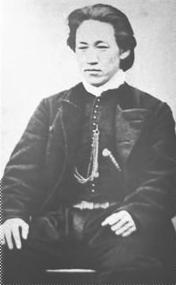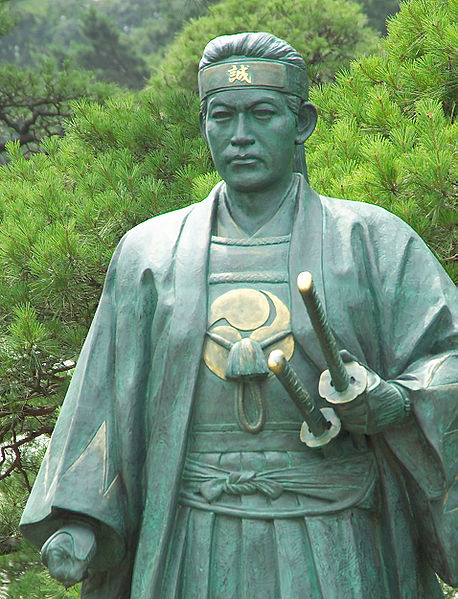<Back to Index>
- Mathematician and Computer Scientist John George Kemeny, 1926
- Painter Andrea Appiani, 1754
- Shinsengumi Fukuchou Hijikata Toshizō Yoshitoyo, 1835
PAGE SPONSOR


Hijikata Toshizō (土方 歳三, May 31, 1835 – June 20, 1869) was the vice - commander of Shinsengumi, a great swordsman and a talented Japanese military leader who resisted the Meiji Restoration.
Hijikata Toshizō Yoshitoyo was born on May 31, 1835 in present day Hino, a suburb of Tokyo. He was the youngest of six children, and his father, a well - to - do farmer, died shortly before his birth. Hijikata's mother also died when he was a young boy, and he was therefore raised by his older brother and sister - in - law.
A small built man, he was spoiled at an early age and was alleged to be mean to all but his friends and family. This changed when a 21 year old swordsman from the Aizu clan known for opposing the Reformists was forced to commit seppuku (ritual suicide). When Hijikata attended the man's funeral, he apparently cried in public.
Hijikata spent his youth selling his family's Ishida Sanyaku (medicine for treating injuries such as bruises and broken bones) while practicing his self - taught kenjutsu. His brother - in - law, Satō Hikogorō, managed a Tennen Rishin - ryū dojo in Hino; through Sato, Hijikata met the later Kondō Isami and was formally enrolled at the Tennen Rishin - ryū's Shieikan in 1859. Although Hijikata himself never fully mastered the Tennen Rishin - ryū, it is said that he managed to develop the "Shinsengumi - Kenjutsu" fighting style from the Tennen Rishin - ryū.
In 1863, he and Kondō Isami formed the Shinsengumi. Kondō and two other men, Serizawa Kamo and Niimi Nishiki, became joint leaders of the group, and Hijikata served as one of the deputy leaders. Shinsengumi served as a special police force in Kyoto that fought against the Reformists under Matsudaira Katamori, the Daimyo of Aizu.
However, Serizawa and Niimi began fighting, drinking, and committing extortion in Kyoto, which started to tarnish the reputation of Shinsengumi and earned the group the derogatory nickname of "Wolves of Mibu" (壬生狼 miburō). Hijikata found enough proof against Niimi in these matters and ordered him to commit seppuku. Serizawa and his followers, however, were assassinated, and Kondo became the sole leader of Shinsengumi with Yamanami Keisuke and Hijikata as his vice - commanders.
The group grew to 140 men, which included a number of farmers and merchants whose livelihood would be threatened if the Tokugawa Shogunate was overthrown. The regulations set up by Shinsengumi within Kyoto were strict and Hijikata was known to be harsh in enforcing them, hence his nickname: "The Demon of the Shinsengumi". Even within the Shinsengumi itself, regulations were strictly enforced by Hijikata. Deserters and traitors were forced to commit seppuku; this happened to Yamanami (one of Hijikata's old friends) when he tried to leave Shinsengumi in 1865.
Hijikata owned a sword made by renowned swordsmith Izumi - no - Kami Kanesada (和泉守兼定) that was forged during the Edo period, and it is said that he developed the standard Shinsengumi fighting style, "Shinsengumi - Kenjutsu".
Together with the rest of the Shinsengumi, Hijikata became a hatamoto in 1867. He was given the rank of yoriai (yoriai - kaku 寄合格) in early 1868.
After Kondo surrendered to the Imperial Loyalist Army and was executed on May 17 (lunar calendar April 25) 1868, Hijikata led Shinsengumi on their final battles against the new government. After a time in Aizu, he went to Sendai, where he joined up with Enomoto Takeaki's fleet. He knew he was fighting a losing battle, and told the physician Matsumoto Ryojun that "I am not going to battle to win. With the Tokugawa government about to collapse, it would be a disgrace if no one is willing to go down with it. That is why I must go. I will fight the best battle of my life to die for the country".
In October 1868, Hijikata and Ōtori Keisuke led Shogunate forces to occupy the fortress of Goryōkaku in the Battle of Hakodate, and continued to eliminate local resistance. When the short lived Ezo Republic was founded in December, Hijikata was made a vice - minister of the Army. Imperial troops continued to attack by land and sea. In the final conflict of the revolution, on June 20 (lunar calendar May 11), 1869, Hijikata was killed while in combat on horseback by a bullet that shattered his lower back. A week after his death, the Goryōkaku fortress was taken, and the military of Ezo Republic surrendered to the Meiji government on May 17, 1869.
It is unknown where Hijikata was buried, but a memorial gravestone stands near Itabashi Station in Tokyo, next to Kondō Isami's. The death poem entrusted to Ichimura Tetsunosuke shortly before Hijikata's death reads:
Though my body may decay on the island of Ezo, My spirit guards my lord in the east.
The Shinsengumi have become a popular subject for films, television, and manga and anime, ranging from historical drama to comedy and romance. As a leader of the group, Hijikata is usually a prominent character in such productions. Though the treatment varies, he is typically portrayed as a tragic hero, representing the end of the warrior age and the "last of the samurai".
Hijikata is depicted in the 1999 film Gohatto ('Taboo') (played by Takeshi Kitano), and the 2004 NHK Taiga drama series Shinsengumi! (including the single episode sequel Shinsengumi!: Hijikata Toshizo Saigo no Ichinichi). He is the protagonist in Morita Kenji's manga Getsumei Seiki, and in Mibu Robin's Baragaki ("Red Demon"). Hijikata is also featured in a number of other anime and manga series, including Peace Maker Kurogane; Kaze Hikaru; Shura no Toki; Gintama (a comedy / alternate universe version); Hijikata Toshizou - Shiro no Kiseki (a short OVA); Bakumatsu Kikansetsu Irohanihoheto; Tenpou Ibun Ayakashi Ayashi; the yaoi manga Soshite Haru no Tsuki, and the popular otome game / anime series Hakuouki: Shinsengumi Kitan (in which he is the romantic lead) he appears in Kouta Hirano's new work called Drifters as an Antagonist rather than a protagonist.
He was also said to be the deceased father of the fifteen year old, female protagonist in the manga Hakodate Youjin Buraichou Himegami by Tamaki Nozomu.